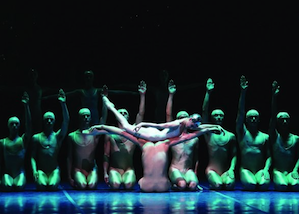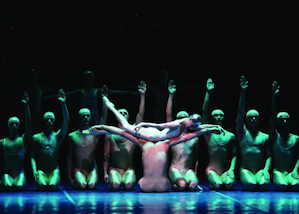
Since its premiere in 1977, the Hamburg Ballet has taken Artistic Director John Neumeier’s A Midsummer Night’s Dream to hundreds of venues around the world, bringing it last Wednesday and Thursday nights to the War Memorial Opera House under the auspices of the San Francisco Ballet. Easy to see why it travels so well. It’s neoclassicism on a grand scale, with dazzling costumes, magical settings, a full orchestra, and plenty of fine dancers. And it’s long, checking in at two hours and 40 minutes. But it’s winsome, often silly; romantic and approachable. And you can’t beat Felix Mendelssohn — Neumeier proves it by interpolating the dissonance of Ligeti’s Volumnia, among other distractions. The San Francisco Ballet Orchestra was conducted by Hamburg Ballet conductor Michael Schmidtsdorff.
There are other Dreams, notably George Balanchine’s for the New York City Ballet (premiered in 1962). It’s a whole different animal; Balanchine’s, to this reviewer, is unequivocally better. Balanchine’s is more privately lavish, if you will, with closeup views of the myriad characters that reveal more of their personalities than the Neumeier ballet. Balanchine’s maintains a sharp focus, albeit a thoroughly enchanting one, moving toward the resolution that untangles all the mistaken identities and mismatches, followed by a sumptuous wedding celebration. It’s all Mendelssohn, and just 95 minutes long.
Neumeier’s though, is great fun. He is a practitioner of opera house ballet — you walk in, sit down, slow down, relax, let your gaze roam as the assembled and arrayed talents come and go, take in Jurgen Rose’s fantastic costumes and scenery, and let the thing pull you along, gradually. You don’t pull it. All will be resolved — but all in due time. The choreography is particularly flattering to the corps. But the dances sometimes feel aimless.
Neumeier serves his principal characters well, and there are plenty. Prime among them is Hippolyta/Fairy Queen Titania (Helene Bouchet; famed ballerina Elena Cojocaru guested Thursday night). We first see Hippolyta being fitted for her wedding gown; she’s to marry Theseus, the Duke of Athens. Its huge train is a hint of the lavishness that will follow with all manner of gilt decor, staggering bouquets, silk swaths and showers of stars, shimmering trees, and satin weskits. As for the bride, she’s everything a princess bride should be, and an elegant, light-as-air ballerina too. Her partner, Theseus/Oberon, King of the Elves (Thiago Bordin), generates a pleasant heat in the palace as well as in the woods, where he quarrels with Titania.
This leads him to give a magic flower to Puck (Alexandr Tusch) to shake over Titania so that when she awakens, Oberon will be first person she sees, and thence the object of her affections once again. It doesn’t quite go smoothly. Instead, she falls in love with Bottom, an ass, one of a side-splitting gang of Craftsmen, as Shakespeare’s Rude Mechanicals are called here. In this version they’re led around like a choo-choo by Klaus (Eduardo Bertini) and his barrel organ.
In the course of all the happy mayhem, we meet Helena and Hermia (Silvia Azzoni and Anna Laudere), two friends of Hippolyta’s, each in love with oh, someone — Lysander or Demetrius (Edvin Revazov or Otto Bubenicek) — and also subject to Puck’s floral flourishes. Lysander, a gardener, is a hearty, sweet, and earthy chap, perhaps not the brightest knife in the drawer. He’s Hermia’s perfect match. Azzoni’s Helena, when we first meet her, is the girl in glasses men never make passes at. She launches herself at the uptight, upright Demetrius. This she does horizontally, vertically, and engulfingly. It’s slapstick enacted to perfection. Titania, eventually reunited with Oberon, rides him like a hood ornament, in a series of uncomfortable lifts.
The fairy unitards are unisex, too. Surmounted by silvery caps, they’re 1970s throwbacks; in the day, it seemed as if every other ballet, especially at the Joffrey, was encased in them.
Of all the characters, it’s Bordin’s Puck — another dual role; in the palace, he’s Philostrate, master of the revels — who’s the most winning. Bordin can move easily between comedy and graciousness. He’s got a compact, tremendously elastic body, and he invests both characters and their dance with a quality of steady concentration that still feels light and breezy.
After all has been resolved and unraveled and the pro forma, somewhat tiresome wedding processions and hierarchies are seen to, we get to the real production, Pyramus and Thisbe, performed as a nuptial street-theater tribute. Enacted by the Craftsmen, it includes two men as the Wall; one as a Lion; a guy holding a lantern as the moon, and, best for last, Bottom, now the knife-rattling Pyramus (Carsten Jung) and Flute, now Thisbe in red pointe shoes (Konstantine Tselikov). Thisbe’s a sturdy ballerina, Pyramus is silly perfection as a baffled warrior, and it’s a fine burlesque of a finish.

